The Prince of Humbugs
by Bob Brooke
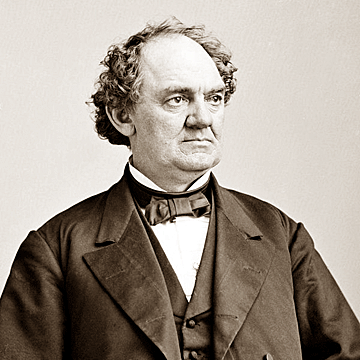 By
the time he had reached his 50th birthday, Phineas Taylor Barnum from
Bethel, Connecticut, had remade himself from his humble beginnings as an
impoverished country boy into a showman. By
the time he had reached his 50th birthday, Phineas Taylor Barnum from
Bethel, Connecticut, had remade himself from his humble beginnings as an
impoverished country boy into a showman.
A combination of brilliant marketing tactics and less-than-upstanding
business practices, Barnum had truly arrived. To counteract his growing
reputation as a scam artist, he published Humbugs of the World, a book
showing that he hadn’t achieved his success by scamming anyone.
Barnum's career trafficked in curiosities, which he served up to a
public hungry for them, regardless of how factual or ethical such
displays. His legacy in show business stretched from the American Museum
to "P. T. Barnum's Grand Traveling Museum, Menagerie, Caravan &
Hippodrome." Each were full of bigger-than-life ideas marketed to an
audience interested in mass, and often crass, entertainment.
Barnum defined “humbug” as the putting on of glittering displays and
novel exhibits, to attract the public’s attention. Barnum defended this
practice. He claimed no harm or foul, so long as at the end of the day,
customers felt like they had gotten their money’s worth.
How Barnum Got Started with Humbugs
By the time he was 25, Barnum had tried working as a lottery manager, a
shopkeeper and newspaper editor. He was living in New York City,
employed at a boarding home and in a grocery store, and was hungry for a
money-making gimmick.
Barnum became a small business owner in his early twenties and founded a
weekly newspaper before moving to New York City in 1834. He embarked on
an entertainment career, first with a variety troupe called "Barnum's
Grand Scientific and Musical Theater", and soon after by purchasing
Scudder's American Museum which he renamed after himself. He used the
museum as a platform to promote hoaxes and human curiosities such as the
Fiji mermaid and General Tom Thumb.
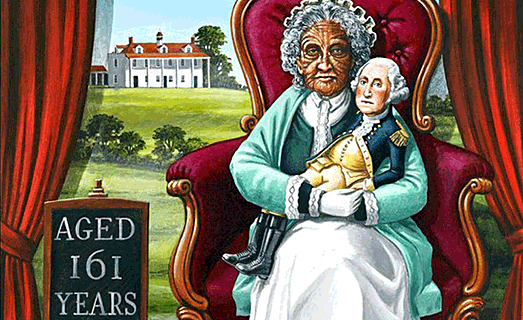
For $1,000 for a year, he
rented an old, nearly blind and partially paralyzed black woman, Joice
Heth, whom an acquaintance promoted around Philadelphia as the
161-year-old former nurse of George Washington. Barnum saw a chance to
get rich with Heth, even though Heth wasn’t even alive during
Washington’s time.
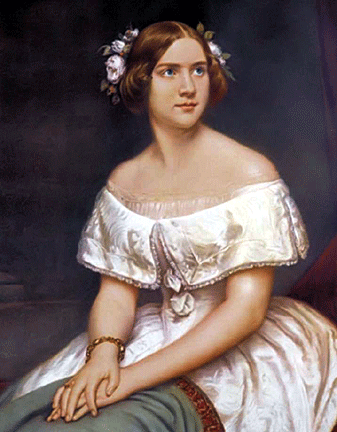 It
was while on tour with her that he discovered a public hungry for
spectacle. “Human curiosities, or lusus naturae—freaks of
nature—were among the most popular traveling entertainments of the late
18th and early 19th centuries. In the 1830s the display of grotesquely
embodied human forms was for some a form of popular carnival-style
entertainment. It
was while on tour with her that he discovered a public hungry for
spectacle. “Human curiosities, or lusus naturae—freaks of
nature—were among the most popular traveling entertainments of the late
18th and early 19th centuries. In the 1830s the display of grotesquely
embodied human forms was for some a form of popular carnival-style
entertainment.
When Heth died in February 1836, at no more than 80 years old. Rather
than let her go in peace, Barnum had one more act up his sleeve. He
drummed up a final public spectacle, hosting a live autopsy in a New
York Saloon. There, 1500 spectators paid 50 cents to see the dead woman
cut up, “revealing” that she was likely half her purported age.
After Heth, Barnum found several other acts to tour—notably the coup of
getting the world-famous Jenny Lind, “the Swedish Nightingale,” to
travel across the Atlantic to make her critically and popularly
acclaimed American debut with him—until he became the proprietor of the
American Museum in December 1841 in New York.
Barnum’s American Museum
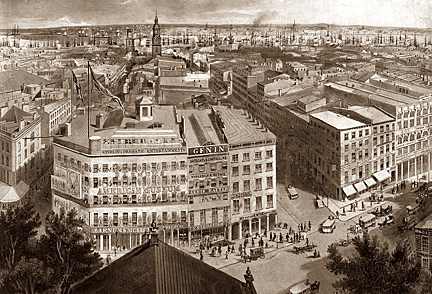 He
purchased Scudder's American Museum in 1841, located at Broadway and Ann
Street, New York City. He improved the attraction, upgrading the
building and adding exhibits, then renamed it "Barnum's American
Museum"; it became a popular showplace. He added a lighthouse lamp which
attracted attention up and down Broadway and flags along the roof's edge
that attracted attention in daytime, while giant paintings of animals
between the upper windows drew attention from pedestrians. The roof was
transformed to a strolling garden with a view of the city, where he
launched hot-air balloon rides daily. A changing series of live acts and
curiosities were added to the exhibits of stuffed animals, including
albinos, giants, little people, jugglers, magicians, exotic women,
detailed models of cities and famous battles, and a menagerie of
animals. He
purchased Scudder's American Museum in 1841, located at Broadway and Ann
Street, New York City. He improved the attraction, upgrading the
building and adding exhibits, then renamed it "Barnum's American
Museum"; it became a popular showplace. He added a lighthouse lamp which
attracted attention up and down Broadway and flags along the roof's edge
that attracted attention in daytime, while giant paintings of animals
between the upper windows drew attention from pedestrians. The roof was
transformed to a strolling garden with a view of the city, where he
launched hot-air balloon rides daily. A changing series of live acts and
curiosities were added to the exhibits of stuffed animals, including
albinos, giants, little people, jugglers, magicians, exotic women,
detailed models of cities and famous battles, and a menagerie of
animals.
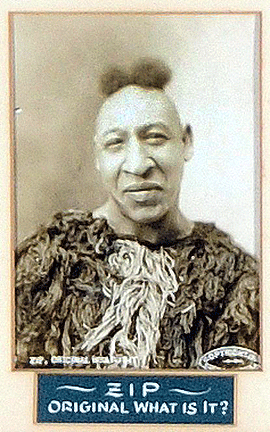 At
the American Museum, more than 4,000 visitors plunked down 25 cents to
browse some 850,000 “interesting curiosities.” The fake and the real
commingled in the space, with imported, exotic live animals mixing
alongside hoaxes like the so-called Feejee mermaid, a preserved monkey’s
head sewn onto the preserved tail of a fish. At
the American Museum, more than 4,000 visitors plunked down 25 cents to
browse some 850,000 “interesting curiosities.” The fake and the real
commingled in the space, with imported, exotic live animals mixing
alongside hoaxes like the so-called Feejee mermaid, a preserved monkey’s
head sewn onto the preserved tail of a fish.
Most uncomfortably, in the museum, Barnum continued to present
“freakishness” in the form of “living curiosities.” One of the most
popular displays featured a man billed as “a creature, found in the
wilds of Africa,” supposed to be a mixture of the wild native African
and the orangutang, a kind of man-monkey. The offensive poster
concluded: “For want of a positive name, the creature was called ‘WHAT
IS IT?’”
In truth, WHAT IS IT? was an African-American man named William Henry
Johnson. Before coming to the show, he served as a cook for another
showman in Barnum’s Connecticut hometown. Similar racial othering
permeated the rest of Barnum’s “living curiosities,” from the “Aztec”
children who were actually from El Salvador, to the real, but exoticized,
“Siamese Twins,” Chang and Eng.
His First Major Humbug
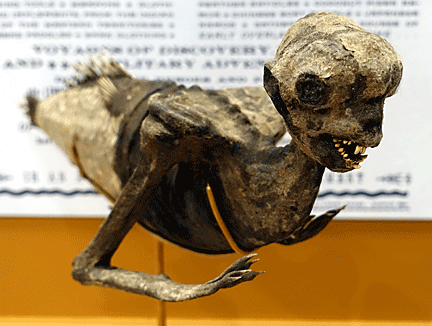 In
1842, Barnum introduced his first major hoax: a creature with the head
of a monkey and the tail of a fish known as the "Feejee" mermaid. He
leased it from fellow museum owner Moses Kimball of Boston who became
his friend, confidant, and collaborator. In
1842, Barnum introduced his first major hoax: a creature with the head
of a monkey and the tail of a fish known as the "Feejee" mermaid. He
leased it from fellow museum owner Moses Kimball of Boston who became
his friend, confidant, and collaborator.
He followed the mermaid by exhibiting Charles Stratton, the dwarf called
"General Tom Thumb" who was actually four years old, even though Barnum
stated that he was 11. With heavy coaching and natural talent, the boy
was taught to imitate people from Hercules to Napoleon. He was drinking
wine by age 5 and smoking cigars by age 7 for the public's amusement.
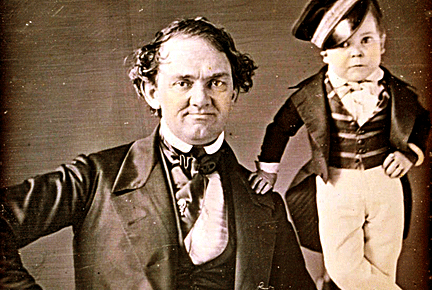 In
1843, Barnum hired American Indian dancer Fu-Hum-Me, the first of many
Indians whom he presented. Between 1844 and 1845, he toured with General
Tom Thumb in Europe and met Queen Victoria, who was amused but saddened
by the little man, and the event was a publicity coup. It opened the
door to visits from royalty throughout Europe, including the Tzar of
Russia, and enabled Barnum to acquire dozens of new attractions,
including automatons and other mechanical marvels. By late 1846,
Barnum's Museum was drawing 400,000 visitors a year. In
1843, Barnum hired American Indian dancer Fu-Hum-Me, the first of many
Indians whom he presented. Between 1844 and 1845, he toured with General
Tom Thumb in Europe and met Queen Victoria, who was amused but saddened
by the little man, and the event was a publicity coup. It opened the
door to visits from royalty throughout Europe, including the Tzar of
Russia, and enabled Barnum to acquire dozens of new attractions,
including automatons and other mechanical marvels. By late 1846,
Barnum's Museum was drawing 400,000 visitors a year.
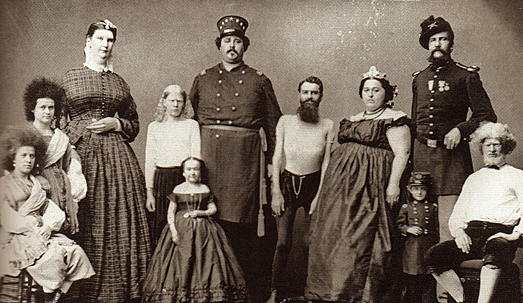
Also in 1860, Barnum introduced "man-monkey" William Henry Johnson, a
microcephalic black dwarf who spoke a mysterious language created by
Barnum. In 1862, he discovered giantess Anna Swan and Commodore Nutt, a
new Tom Thumb with whom Barnum visited President Abraham Lincoln at the
White House. During the Civil War, his museum drew large audiences
seeking diversion from the conflict. He added pro-Unionist exhibits,
lectures, and dramas, and he demonstrated commitment to the cause. He
hired Pauline Cushman in 1864, an actress who had served as a spy for
the Union, to lecture about her "thrilling adventures" behind
Confederate lines. Barnum's Unionist sympathies incited a Confederate
sympathizer to start a fire in 1864. Barnum's American Museum burned to
the ground on July 13, 1865 from a fire of unknown origin. Barnum
re-established it at another location in New York City, but this also
was destroyed by fire in March 1868. The loss was too great the second
time, and Barnum retired from the museum business.
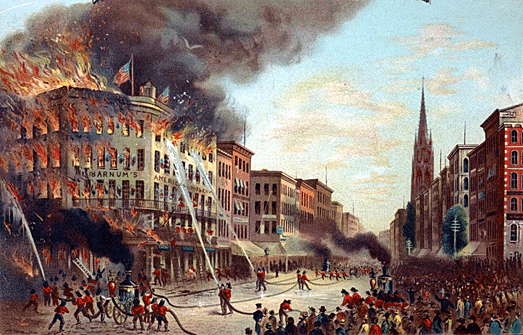
At his death, critics praised Barnum for good works and called him an
icon of American spirit and ingenuity. He asked the Evening Sun to print
his obituary just prior to his death so that he might read it. On April
7, 1891, Barnum asked about the box office receipts for the day. A few
hours later, he died from a stroke at home.
<
More Special Features
Next Article > |
